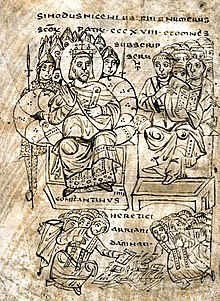
Back Kristologiaj doktrinoj de la unuaj jarcentoj Esperanto Dottrine cristologiche dei primi secoli Italian

| Part of a series on the |
| History of Christian theology |
|---|
 |
|
|
Traditionally in Christianity, orthodoxy and heresy have been viewed in relation to the "orthodoxy" as an authentic lineage of tradition. Other forms of Christianity were viewed as deviant streams of thought and therefore "heterodox", or heretical. This view was challenged by the publication of Walter Bauer's Rechtgläubigkeit und Ketzerei im ältesten Christentum ("Orthodoxy and Heresy in Earliest Christianity") in 1934. Bauer endeavored to rethink Early Christianity historically, independent from the views of the current church. He stated that the 2nd-century church was very diverse and included many "heretical" groups that had an equal claim to apostolic tradition. Bauer interpreted the struggle between the orthodox and heterodox to be the "mainstream" Church of Rome struggling to attain dominance. He presented Edessa and Egypt as places where the "orthodoxy" of Rome had little influence during the 2nd century. As he saw it, the theological thought of the "Orient" (in this case the Eastern Roman Empire) at the time would later be labeled "heresy". The response by modern scholars has been mixed. Some scholars clearly support Bauer's conclusions and others express concerns about his "attacking [of] orthodox sources with inquisitional zeal and exploiting to a nearly absurd extent the argument from silence."[1] However, modern scholars have critiqued and updated Bauer's model.[2]
According to Keith Hopkins, the claimed institutional unity of the Christian Church was propaganda constantly repeated by orthodox Christian writers, rather than a genuine historical reality.[3]
- ^ Ehrman 2003, p. 173.
- ^ Hunt (2003). Pp 10–11.
- ^ Hopkins 2017, p. 457: But, per contra, it is extremely difficult for dispersed and prohibited house cult-groups and communities to maintain and enforce common beliefs and common liturgical practices across space and time in pre-industrial conditions of communications.43 The frequent claims that scattered Christian communities constituted a single Church was not a description of reality in the first two centuries AD, but a blatant yet forceful denial of reality. What was amazing was the persistence and power of the ideal in the face of its unachievability, even in the fourth century. On a local level, it is also unlikely that twenty households in a typical community, let alone a dozen households in a house cult-group, could maintain even one full-time, non-earning priest. Perhaps a group of forty households could, especially if they had a wealthy patron. But for most Christian communities of this size, a hierarchy of bishop and lesser clergy seems completely inappropriate.
© MMXXIII Rich X Search. We shall prevail. All rights reserved. Rich X Search